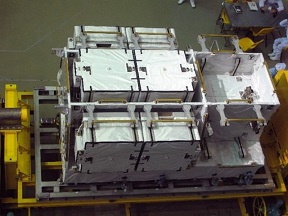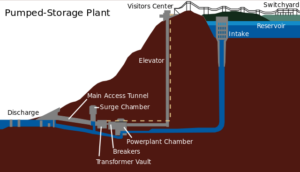Energy storage doesn’t dominate the news. Sustainable energy gets all the credits: solar, wind, hydropower. But these can only make a difference when combined with energy storage. And the good news is: this is in rapid development.

High prices, rapid innovation
The Ukraine war has propelled us into a new era. Energy has become expensive – its price is not determined any more by the world market, but by strategic availability. High prices are a major driving force in the energy transition. And that will hold for energy storage as well.
Energy storage is the forgotten little brother of sustainable energy. The sun doesn’t always shine, the wind doesn’t blow at times – that’s why we need energy storage. All the more so as the share of sustainable energy is rising. Far from the limelight, researchers developed such storage systems long ago already. Batteries: Li-ion (now for sale everywhere), Na-ion and zinc-sulphur (in development, expected to come to the market within ten years). A little further away: solid state batteries, that don’t use fluids; they are safer and live much longer. Scores of other concepts are in development. Prices came down accordingly. In 1992, batteries still cost € 6,000 per kWh storage, now this price has come down to € 140. Therefore, they are in demand. All batteries in the world taken together can already power the Netherlands, and their capacity grows fast.
Domestic storage
There are batteries on the market for domestic use already. A home storage kit by Tesla cost € 6,500 in 2022; the storage capacity being 14.4 kWh – enough for a weekend in an average home. Generally, electric car batteries contain 80-100 kWh, enough for one to two week’s domestic use. And there are commercial suppliers already who offer larger volumes. A Tesla Megapack fits in a container and contains 3 MWh, enough to power 100 to 150 households for a day. Ebusco in Deurne (the Netherlands) builds electric buses (it has now supplied some 300) and sells a comparable container storage. Dutch energy company Eneco and project developer GIGA Storage recently built the GIGA Buffalo in Lelystad (the Netherlands); a large battery filled with renewable energy, that can deal with peaks in electricity demand.

Proposals for energy storage used to be large-scale and expensive. Copies of reservoirs at a smaller scale. The Plan Lievense in the Netherlands, consisting of a high dike around an artificial lake. A hole in the sea, proposed by the Das bothers. In mountainous areas, pump accumulation units are still in use. These pump water into a reservoir as electricity is cheap – and use the energy as electricity is expensive. And nowadays there are storage tanks filled with electrolytes, that can also supply electricity if in demand. We can also store heat: in soapstone or in basalt. But as yet, none of these solutions have the ideal combination of properties: a high storage capacity (like in batteries and fuel cells) combined with a high charging and discharging speed (like in capacitors). There is still room for innovation!
More innovations
Other plans target energy storage in the form of hydrogen. Easy to produce through electrolysis of water – but commercial application does require dirt cheap electricity to start with. The Middle East for instance could start to build such hydrogen factories. We can also store energy in the form of iron powder. For energy production we convert this to iron oxide (rust); that we can reduce to iron again, using hydrogen. This material is easier to transport than hydrogen. We live in an era of many possibly promising technological opportunities. Consider for instance compressed air, possibly stored in disused mines. Liquid air. Flywheels. Magnetic superconductors. Chemical storage.
The grid’s function will change considerably, if electricity would be mainly supplied by solar panels and wind turbines. This is still the weak point in sustainable energy projects. In the past, the grid has become very centralized. Large power stations transport electricity to remote places through the grid. But in the future, electricity will be produced precisely in these remote places. A compelling reason to start optimizing the electricity system locally now. By levelling out surpluses and shortages at the local scale; in order to prevent electricity to be transported across major distances. Such a system needs to be developed now. And we can do that. Take as an example the plans in isolated areas, like in the Danish island of Bornholm. Small scale electricity producing units (wind turbines, solar panels) require an optimization at the small scale. It all boils down to that simple equation. The role of the grid is going to change. From transport to levelling out.
The time is ripe
In the course of time, the best solutions will surface. Now we are in the middle of the innovation phase: many new technologies are being developed, struggling for dominance. A nervous time for developers. A necessary phase for preparation of the next step in the energy transition. The assured delivery of sustainable energy.
Written together with Diederik van der Hoeven
Interesting? Then also read:
Cheap energy storage speeds up
Energy storage, its role in the transition
Solid state battery: new breakthrough

It should be understood that an energy storage system is not just a battery; the world’s leading companies put a slightly different meaning into this concept. They offer the consumer a comprehensive solution that includes both batteries (storage devices) and software solutions that monitor the condition of the storage devices and ensure optimal load distribution. Therefore, maintenance and control are no less important than the choice of energy storage technology itself.